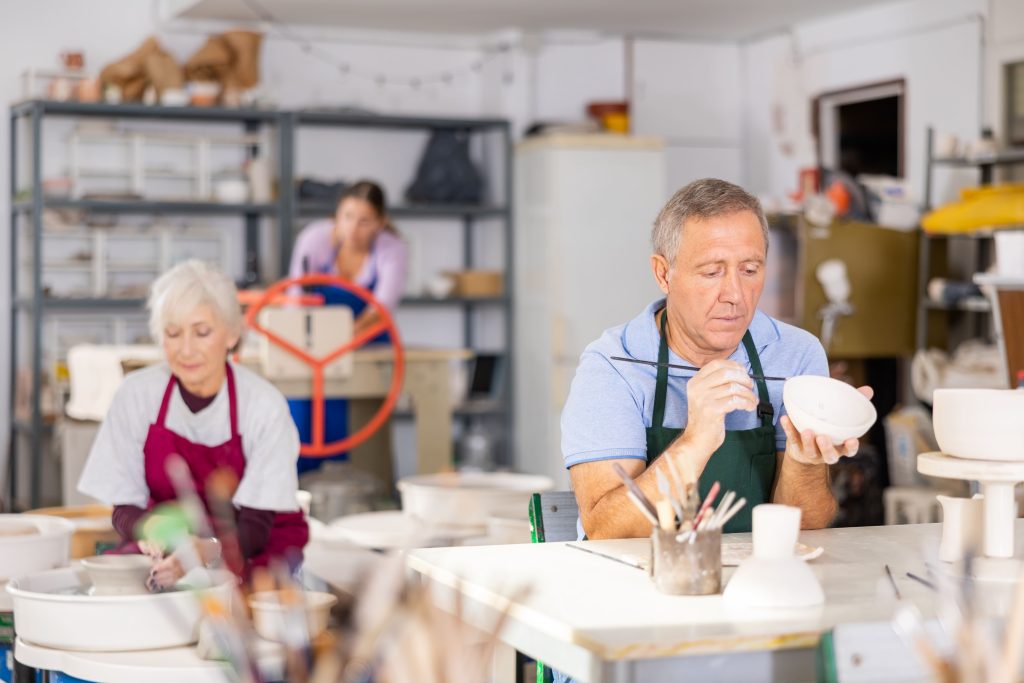As we get older, our needs change. For adults, one of the most important needs is to keep their minds and bodies active. Crafts for adults are a great way to meet this need. The Journal of Aging and Health says that crafts for seniors can greatly enhance the mental health and overall well-being. This research makes it clear how important it is for seniors to do projects every day.
For older people, art is more than just a hobby; it’s a way to make their lives better. It includes a lot of different creative tasks that keep you thinking, improve your fine motor skills, and make you feel good about what you’ve done.
Whether it’s drawing, knitting, or sculpting, art gives seniors a way to express themselves, meet new people, and keep their minds sharp. All of these things are important for staying mentally and emotionally healthy as you get older.
Why Are Creative Activities Good for Seniors?
Seniors can benefit from creative activities in many ways, which makes them an important part of a happy life in old age. Making crafts is one activity that older people do that can:
- Enhance cognitive function
- Reduce stress and anxiety
- Improve fine motor skills
- Boost self-esteem and confidence
- Provide opportunities for socialization.
- Offer a sense of purpose and accomplishment.
- Stimulate memory and recall
- Encourage self-expression
- Promote mindfulness and relaxation
- Help maintain independence
Because of these benefits, crafts are a great way for seniors to stay healthy and happy generally.
What Are Some Good Craft Ideas for Adults?
When coming up with craft ideas for seniors, it’s important to think about their different hobbies, abilities, and levels of mobility. Crafts and arts are especially good for people with dementia because they can help them remember things, focus better, and feel like they’ve accomplished something. Many of the projects below can be modified to make them easier for seniors with limited mobility or cognitive challenges.
Top 10 Crafts for Seniors
1. Painting (Easy, Great for People with Dementia)
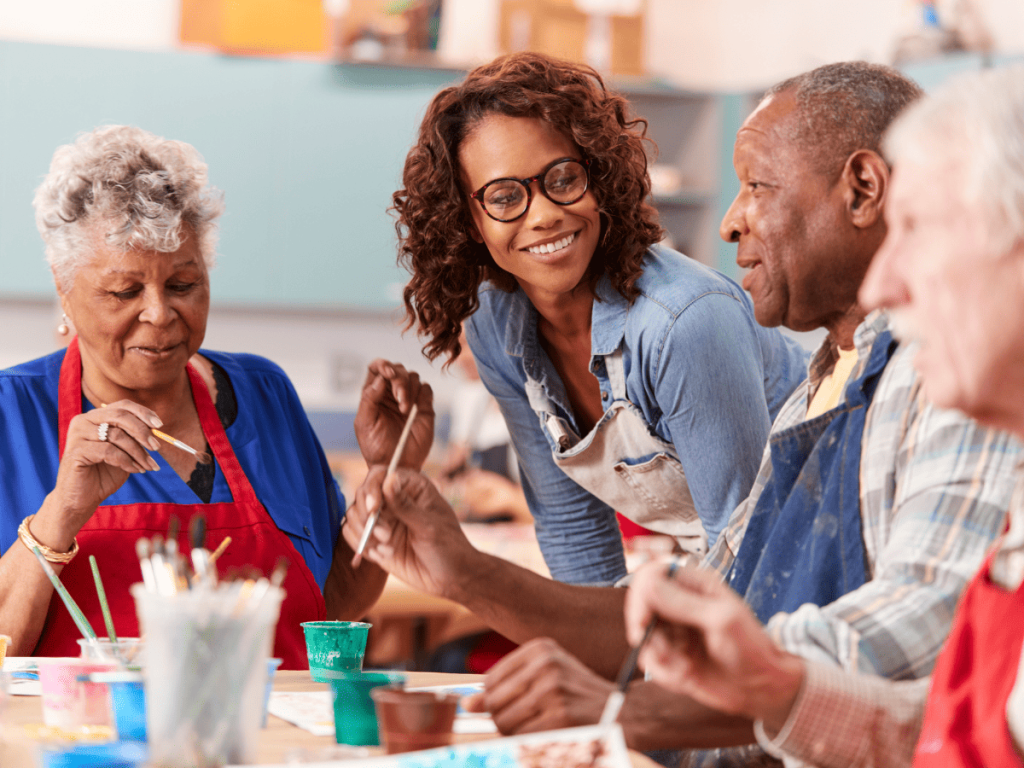
Materials: Canvas or paper, paintbrushes, acrylic or watercolor paints, water, palette
Steps:
- Set up a comfortable workspace with good lighting.
- Choose a subject or reference image.
- Sketch the basic outline on the canvas or paper (optional).
- Mix colors on the palette.
- Begin painting, starting with larger areas and working towards details.
- Allow the paint to dry between layers.
- Add final touches and details.
Painting is an excellent activity for seniors with dementia as it allows for self-expression and can evoke memories.
2. Knitting (Medium)

Materials: Knitting needles, yarn, scissors
Steps:
- Choose a simple pattern for beginners.
- Cast on the required number of stitches.
- Learn basic stitches like knit and purl.
- Follow the pattern, creating rows of stitches.
- Bind off when the project is complete.
- Weave in loose ends
Knitting can improve fine motor skills and provide a sense of accomplishment.
3. Flower arranging/Bouquet making (Easy)
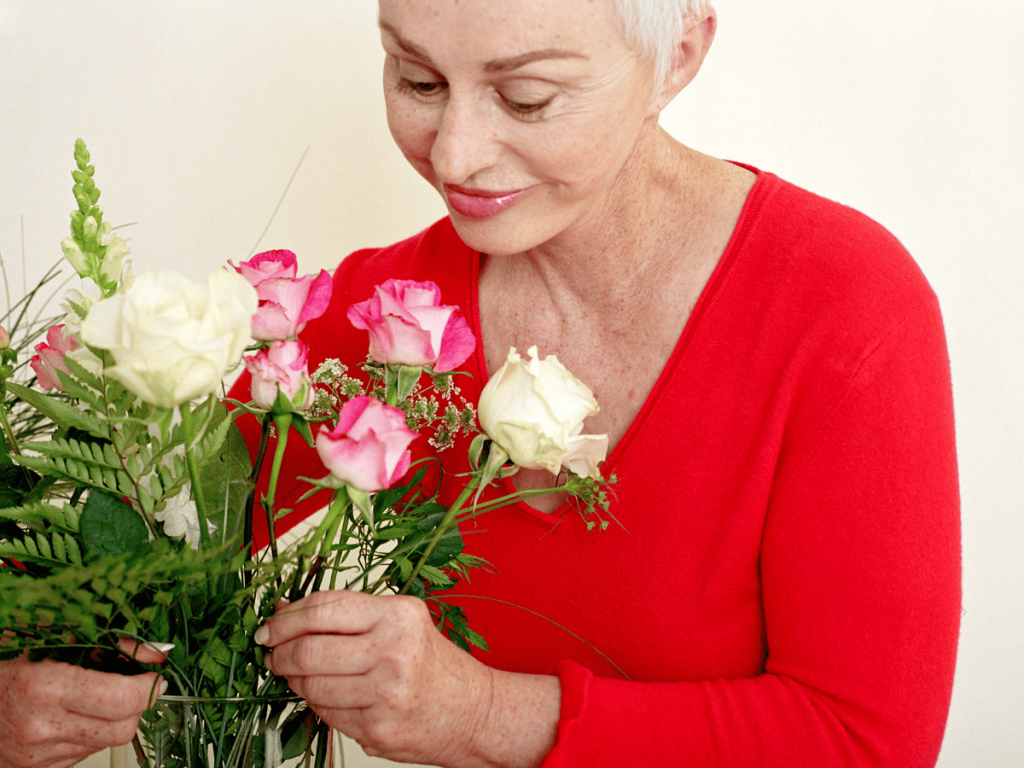
Materials: fresh flowers, vase or bouquet wrap, floral foam (for vase), scissors, water, floral tape (for bouquet)
Steps:
For vase arrangement:
- Fill the vase with water and place floral foam inside.
- Trim flower stems at an angle.
- Start with larger flowers as a base.
- Add smaller flowers and fillers.
- Adjust the arrangement for balance and aesthetics.
For bouquet making:
- Trim flower stems at an angle.
- Group flowers by type and size.
- Start with larger flowers as the center.
- Add smaller flowers and fillers around them.
- Secure stems with floral tape.
- Wrap the bouquet in decorative paper or fabric.
This activity allows seniors to work with nature, create beautiful displays, and make personalized gifts. It stimulates creativity, improves hand-eye coordination, and can be a calming, sensory experience.
This activity allows seniors to work with nature and create beautiful displays.
4. Crocheting (Medium)
Materials: crochet hook, yarn, scissors
Steps:
- Choose a simple pattern for beginners.
- Create a slipknot on the hook.
- Learn basic stitches like chain and single crochet.
- Follow the pattern, creating rows or rounds.
- Fasten off when the project is complete.
- Weave in loose ends
Crocheting can help maintain dexterity and promote relaxation.
5. Card making (Easy)
Materials: Cardstock, decorative paper, scissors, glue, stamps, ink pads, markers
Steps:
- Choose a card size and fold cardstock accordingly.
- Select a theme or occasion for the card.
- Cut and layer decorative papers
- Add stamped images or handwritten messages.
- Embellish with stickers, ribbons, or other decorations.
- Allow glue to dry completely.
Card making is a versatile craft that allows for personalization and creativity.
6. Coloring books for adults (easy, ideal for dementia patients)
Materials: Adult coloring book, colored pencils, or markers
Steps:
- Choose a coloring page.
- Select a color palette.
- Start coloring, focusing on one section at a time.
- Experiment with shading and blending techniques.
- Take breaks as needed to avoid fatigue.
Adult coloring books are excellent for relaxation and can help improve focus in dementia patients.
7. Quilting (Hard)
Materials: fabric squares, batting, backing fabric, sewing machine, thread, scissors, pins
Steps:
- Choose a quilt pattern and cut fabric squares accordingly.
- Arrange squares in the desired pattern.
- Sew squares together to form rows.
- Join rows to create the quilt top.
- Layer quilt top, batting, and backing fabric
- Pin layers together and quilt as desired.
- Bind the edges to finish.
Quilting is a more complex craft that provides a significant sense of achievement.
8. Scrapbooking (Easy to Medium)
Materials: scrapbook album, photos, decorative paper, scissors, glue, stickers, markers
Steps:
- Choose a theme or chronological order for the scrapbook.
- Select and print photos
- Create layouts on scrapbook pages.
- Adhere photos and decorative elements
- Add journaling or captions.
- Embellish pages with stickers or other decorations.
Scrapbooking allows seniors to preserve memories and share stories.
9. Woodworking (Medium to Hard)
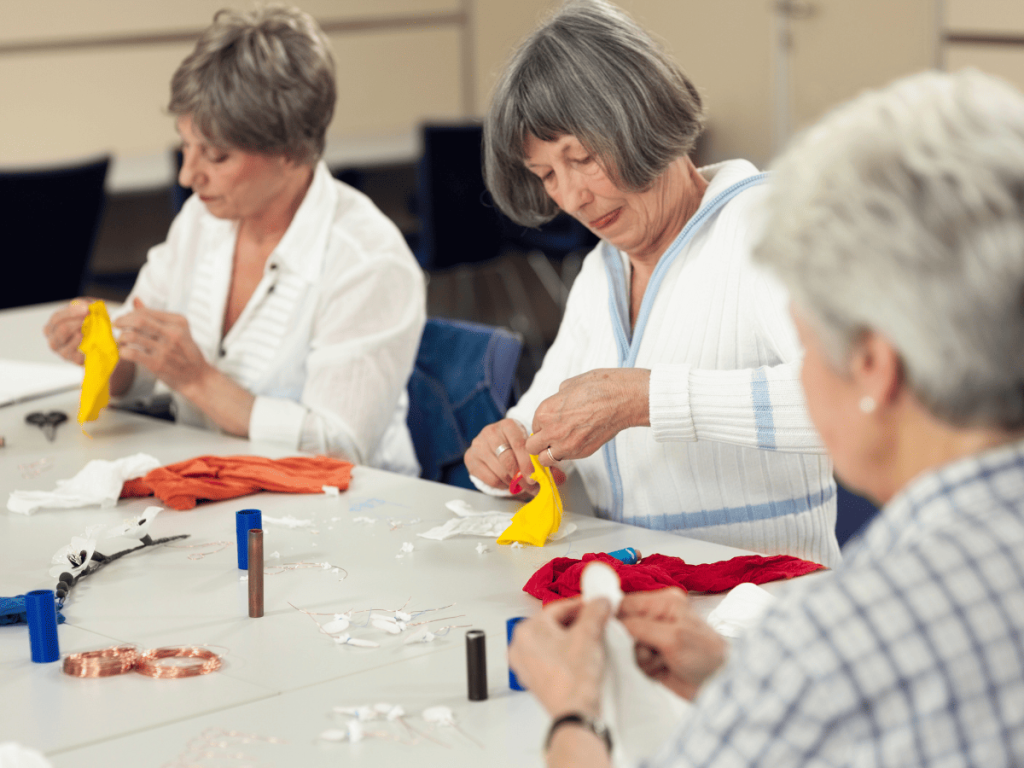
Materials: Wood, saw, sandpaper, wood glue, nails, hammer, paint, or varnish (optional)
Steps:
- Choose a simple woodworking project.
- Measure and mark the wood.
- Cut wood pieces to size
- Sand rough edges
- Assemble pieces using wood glue and nails.
- Allow glue to dry completely.
-
Paint or varnish if desired.
Woodworking can be adapted to different skill levels and provides a tangible result.
10. Jewelry making (Medium)
Materials: Beads, wire or string, pliers, clasps, findings
Steps:
- Choose a jewelry design.
- Cut wire or string to desired length.
- String beads in the chosen pattern
- Attach clasps and findings
- Use pliers to secure connections.
- Trim excess wire or string
Jewelry making allows for personal expression and can result in wearable art.
Other Crafts for Seniors
Painting Crafts:
- Glass painting (Medium): Paint decorative designs on glass surfaces using special glass paints.
- Rock painting (Easy, Ideal for Dementia Patients): Create colorful designs on smooth rocks using acrylic paints.
- Watercolor painting (Easy): Use water-based paints to create light, translucent artworks.
- Silk painting (Medium): Apply fabric paints to silk to create vibrant scarves or wall hangings.
- Fabric painting (Medium): Decorate clothing or fabric items with fabric paints and stencils.
Fiber Arts:
- Embroidery (Medium): Create decorative designs on fabric using a needle and embroidery floss.
- Needlepoint (Medium): Work yarn through a canvas mesh to create intricate designs.
- Macramé (Easy to Medium): Knot cord or rope to create decorative wall hangings or plant holders.
- Sewing (Medium): Use a sewing machine or hand-sew to create simple garments or household items.
- Felting (Easy): Create soft, fuzzy fabric or 3D objects using wool fibers and soap.
- Cross-stitch (Medium): Create pictures or patterns by stitching X-shaped stitches on fabric.
- Latch hook rug making (Easy): Create plush rugs using a latch hook tool and pre-cut yarn.
- Weaving (Medium to Hard): Use a loom to create fabric by interlacing threads.
- Needle felting (Medium): Use special needles to sculpt wool fibers into 3D shapes.
- Bobbin lace making (Hard): Create intricate lace patterns using bobbins and pins.
- Ribbon embroidery (Medium): Embroider designs using silk ribbons instead of thread.
- Silk ribbon embroidery (Medium): Create dimensional floral designs using silk ribbons.
- Kumihimo (Japanese braiding) (Medium): Create intricate braided cords using a disk or stand.
- Tatting (lace making) (Hard): Create delicate lace using a shuttle or needle.
- Punch needle embroidery (Medium): Create textured designs using a special punch needle tool.
Paper Crafts:
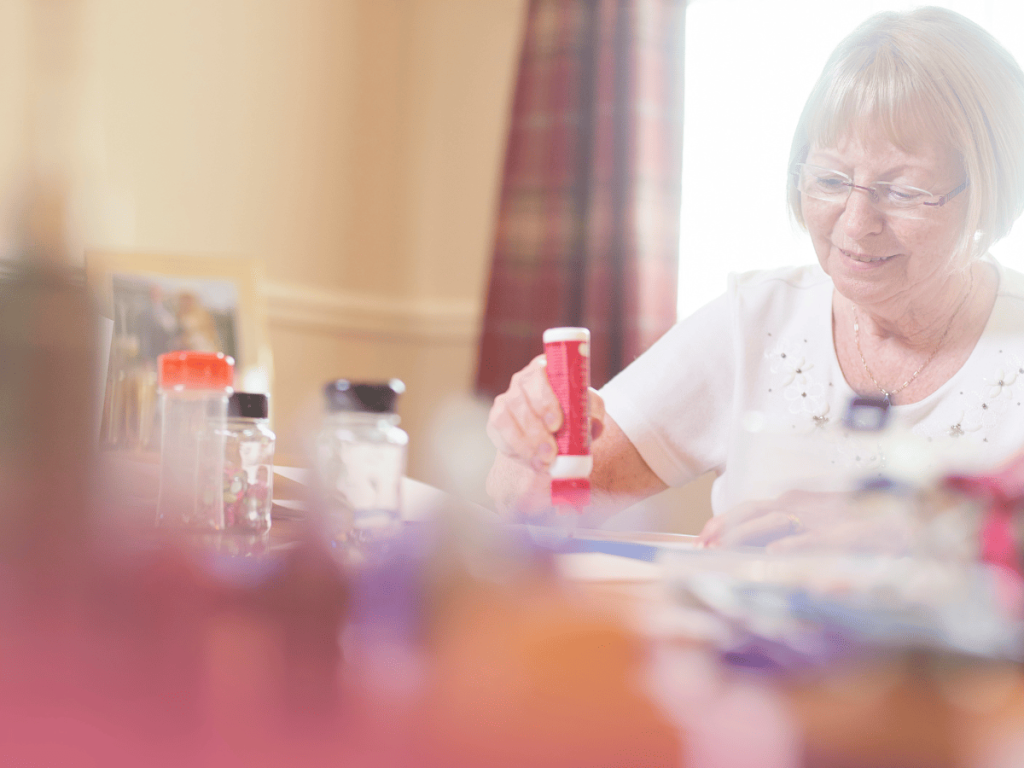
- Origami (Easy, Ideal for Dementia Patients): Create 3D objects by folding paper without cuts or glue.
- Paper quilling (Medium): Roll and shape thin strips of paper to create decorative designs.
- Decoupage (Easy): Decorate objects by gluing paper cutouts and sealing with varnish.
- Papier-mâché (Medium): Create 3D objects using paper strips and paste over a mold.
- Paper flower making (Medium): Craft realistic-looking flowers using colored paper.
- Bookbinding (Hard): Create handmade books by folding, cutting, and binding paper.
- Collage art (Easy, ideal for dementia patients): Create images by gluing various materials onto a surface.
- Quilling (Medium): Roll and shape paper strips to create decorative designs.
- Iris folding (paper craft) (Medium): Create spiraling designs using folded paper strips.
Sculpture and Modeling:
- Pottery (Medium, Ideal for Dementia Patients): Shape clay into functional or decorative objects.
- Polymer clay modeling (Medium): Create small sculptures or jewelry using colorful polymer clay.
Jewelry and Accessories:
- Beadwork (Medium): Create jewelry or decorative items using various beading techniques.
- Resin jewelry making (Medium): Create unique jewelry pieces using clear resin and embellishments.
- Wire wrapping (Medium to Hard): Create jewelry by wrapping wire around stones or beads.
Wood Crafts:

- Birdhouse building (Medium): Construct simple wooden birdhouses using pre-cut pieces.
- Woodburning (Medium): Create designs on wood surfaces using a heated pen.
- Whittling (Medium to Hard): Carve small objects from wood using a knife.
- Pyrography (wood burning) (Medium): Create detailed designs on wood using a heated tool.
Textile Arts:
- Tie-dyeing (Easy, Ideal for Dementia Patients): Create colorful patterns on fabric using dyes and rubber bands.
Nature-based Crafts:
- Terrarium making (Easy): Create mini gardens in glass containers using small plants and decorative elements.
- Pressed flower art (Easy): Preserve and arrange dried flowers to create decorative pieces.
- Shell crafting (Easy): Create decorative items using collected seashells.
- Gourd art (Medium): Decorate or carve dried gourds to create ornamental pieces.
- Pine cone crafts (Easy): Create decorative items using collected pine cones.
- Pressed herb art (Easy): Preserve and arrange dried herbs to create decorative pieces.
Home Decor:
- Candle making (Easy): Create custom candles using wax, wicks, and molds.
- Soap making (Easy): Craft homemade soaps using melt-and-pour or cold-process methods.
- Mosaic art (Medium, ideal for dementia patients): Create images or patterns using small pieces of glass or tile.
- Wreath making (Easy): Create decorative wreaths using artificial flowers, ribbons, and other materials.
- Stained glass crafting (hard): Create colorful glass artworks using cut glass pieces and lead came.
- Windchime creating (Medium): Assemble windchimes using various materials like glass, metal, or wood.
- Miniature garden design (Medium): Create small-scale gardens in containers with tiny plants and accessories.
- Upcycling old furniture (Medium to Hard): Repurpose and refinish old furniture items.
- Dreamcatcher making (Medium): Craft traditional dreamcatchers using hoops, string, and decorative elements.
Miscellaneous Crafts:
- Digital photography (Easy): Capture and edit digital images using cameras or smartphones.
- Leather crafting (Medium): Create small leather goods like wallets or keychains.
- Basket weaving (Medium, ideal for dementia patients): Weave baskets using natural or synthetic materials.
- Calligraphy (Medium): Practice decorative handwriting using special pens or brushes.
- String art (Easy): Create images by wrapping colored string around nails on a board.
- Zentangle drawing (Easy, Ideal for Dementia Patients): Create abstract drawings using repetitive patterns.
- Bottle cap art (Easy): Create mosaics or jewelry using collected bottle caps.
- Tin can crafting (Easy): Repurpose tin cans into decorative items or planters.
- Paracord crafting (Medium): Create useful items like bracelets or keychains using paracord.
Collecting:
- Stamp collecting (Easy, ideal for dementia patients): Collect and organize postage stamps from various countries.
- Coin collecting (Easy, ideal for dementia patients): Collect and organize coins from different eras or countries.
This complete list of crafts for seniors includes a lot of different activities that people with different interests, skill levels, and mobility needs can enjoy.
Activity directors can help improve the quality of life for residents, spark their creativity, and improve their cognitive health by adding these projects to programs for senior community living.
Crafting a Brighter Future: Helping Seniors Live Life to the Fullest Through Crafts
It’s important to remember that crafting is about more than just the end product. It’s also about the process. Getting seniors to learn new skills, deal with challenges, and see a job through to the end can be very empowering. It makes them aware of what they can do and inspires them to keep learning and exploring.
Supporting and starting craft projects with seniors can be a great way for family, friends, and caregivers to connect with them and improve their health. You can help your loved ones find creativity and happiness by giving them tools, help, or just words of support.
Our Pop-up Flower Shop Experience at Horizon Bouquets shares the joy of flowers directly with retirement communities. We’re making seniors’ lives better and building community connections by providing fun and creative floral arranging activities. Our program shows that crafting is fun for everyone and can bring happiness to older members of our community.
Are you a retirement facility looking to enhance your activity calendar? Or perhaps a local florist or vendor interested in partnering with us? Contact Horizon Bouquets today to learn how you can be part of this blooming initiative that’s bringing color and vibrancy to seniors’ lives!

